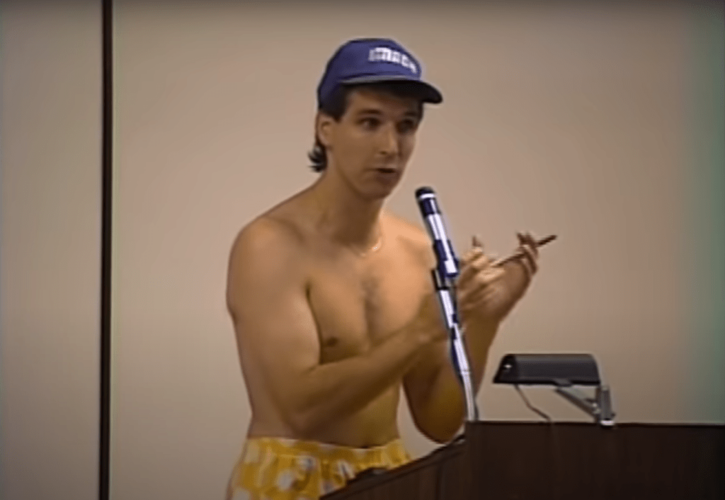Last War in Albion Book Three, Chapter Twelve: 1963

Moore’s move into self-published and wholly independent comics had an obvious cost. The bulk of the Watchmen money had been spent failing to get Mad Love going, and none of Moore’s personal projects were advancing or earning money; A Small Killing was trapped under the crumbling wreckage of Victor Gollancz’s sale, Lost Girls and From Hell were coming out in Steve Bissette’s Taboo, which managed to produce seven issues in five years and only paid $100 per page, to be split between Moore and the artist, and Big Numbers simply didn’t exist. By 1992, Moore was broke and only nominally a comics writer, in that he simply did not have any current projects that were actually coming out anywhere.
And so in the spring of 1992, when Bissette approached him with an offer of work, Moore was receptive, even though it would mean wading back into the mainstream American comics industry that he had so definitively departed five years earlier. Bissette was in fact acting as a messenger—the job offer was from Jim Valentino, who wanted Moore and Bissette to do an issue of a comic called ShadowHawk. And in 1992, Jim Valentino was very possibly the single most interesting man in all of comics.
Valentino got his start in the late 70s/early 80s post-underground scene, appearing in anthologies like Dope Comix alongside underground veterans like Aline Kominsky-Crumb to tell the story of a bad trip on belladonna, or putting out his solo book Yer Basic Comix. He wrote a backup feature for Dave Sim’s Cerebus called normalman, about the one non-superpowered person in a world of superheroes, which eventually turned into a series, first at Sim’s Aardvark-Vanaheim, and then with Renegade Press when Deni Loubert effectively kept the title in the divorce, then went on to do a book of autobiographical comics called simply Valentino.
Eventually his career saw him drift into superheroes, and he settled into a job at Marvel writing and drawing Guardians of the Galaxy. This had been a longstanding minor property at Marvel, first created in 1969 by Doom Patrol co-creator Arnold Drake along with Gene Colan. The team languished in obscurity for two decades hamstrung by the detail that they were from the 31st century and thus largely outside of Mravel continuity, but around the turn of the decade Tom DeFalco, then editor-in-chief at Marvel, saw the concept as a way to cash in on the popularity of the new Star Trek series. Coincidentally Jim Valentino had just worked up a proposal for the characters, having been a fan of the most substantial effort to date to make the spacefaring team work, a stretch of issues by Steve Gerber, who had long been notable as one of the figures in superhero comics with the closest ties to the underground, and so he joined the book as a writer/artist.
Valentino’s work on Guardians of the Galaxy offered a gradual evolution over the twenty-nine issues that he did. On the one hand, his roots as a cartoonist are evident, especially early on, but he was adept at using these as a springboard for clear, expressive storytelling.…

 The racers are on their marks at the starting line. Captain Picard has Data call up the course schematics onscreen. It’s a winding, zigzagging course around the star that will take the racers about three days to traverse, a quick pace for a solar sail vessel. But, as Captain Picard says, “These are the best”. When Commander Riker asks him if he’d rather be “out there”, Jean-Luc replies that he already is. The Enterprise crew wishes all the competitors good luck in turn, but when they get to the Cynosure team, Deanna observes that they’re without their sail technician. Will comments that the Kihin navigator must not have found him “to her taste”, to which Deanna replies “On the contrary…She found him very tasty indeed”. Meanwhile the Thubanir captain is still alive, though Deanna quips that it’s still early yet.
The racers are on their marks at the starting line. Captain Picard has Data call up the course schematics onscreen. It’s a winding, zigzagging course around the star that will take the racers about three days to traverse, a quick pace for a solar sail vessel. But, as Captain Picard says, “These are the best”. When Commander Riker asks him if he’d rather be “out there”, Jean-Luc replies that he already is. The Enterprise crew wishes all the competitors good luck in turn, but when they get to the Cynosure team, Deanna observes that they’re without their sail technician. Will comments that the Kihin navigator must not have found him “to her taste”, to which Deanna replies “On the contrary…She found him very tasty indeed”. Meanwhile the Thubanir captain is still alive, though Deanna quips that it’s still early yet.














